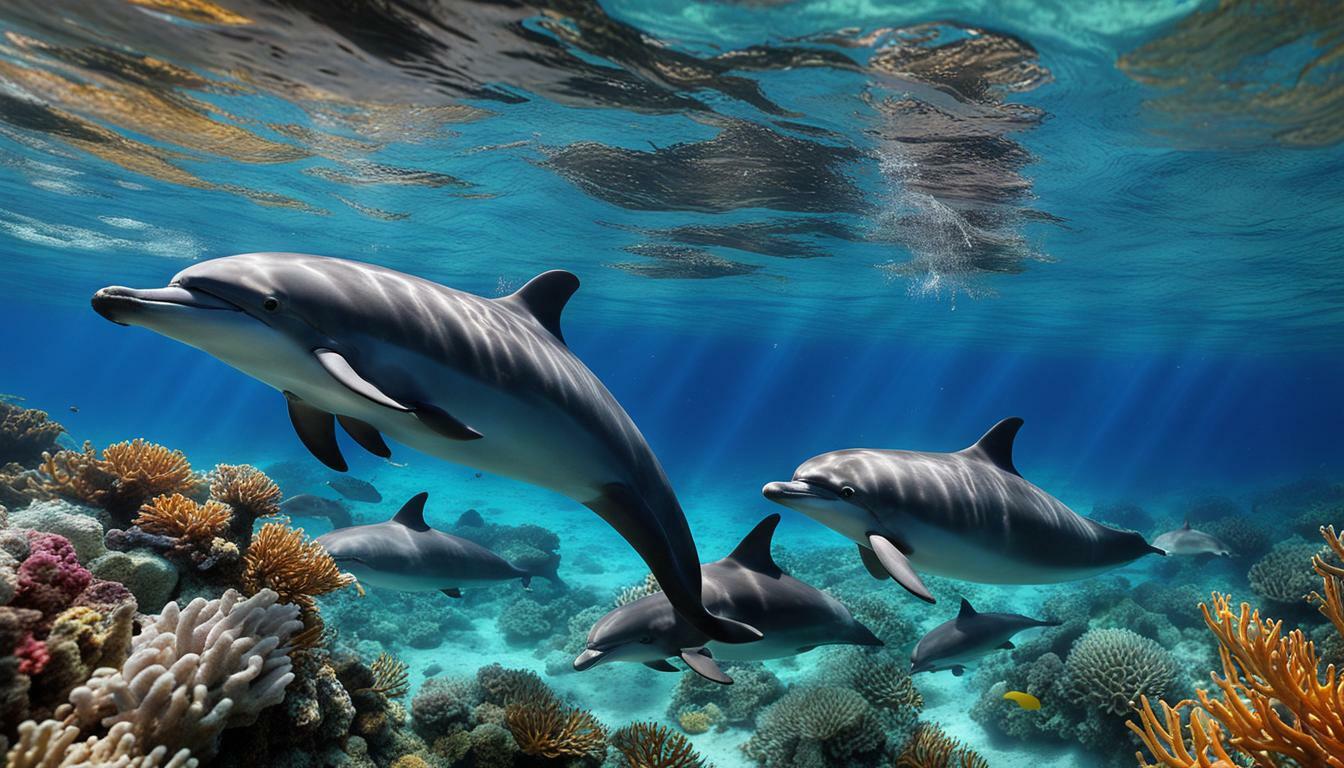Dolphins are fascinating marine mammals that inhabit various parts of the world’s oceans. They can be found in the shallow waters of the ocean’s continental shelves, particularly in tropical and temperate waters. Some dolphin species, like the killer whale, have adapted to living in the deeper ocean waters. But dolphins aren’t limited to the vast ocean alone; they also inhabit rivers in China, South America, India, Pakistan, and Southeast Asia.
One of the most extraordinary examples of dolphin habitat is the Amazon river dolphin, also known as the pink dolphin. These unique dolphins reside in the rainforests and migrate to different areas within the Amazon rivers, showcasing their ability to adapt to diverse environments.
What makes dolphins even more remarkable is their communication skills and social behavior. Using echolocation, dolphins communicate with each other and navigate their natural environment. They are highly intelligent creatures that rely on social bonds within their groups.
Unfortunately, dolphins face various threats that affect their habitats and ecosystems. Hunting, accidental entanglement in fishing nets, habitat loss, and declining populations are some of the challenges they encounter. Protecting their habitats and implementing regulations is crucial for ensuring their continued survival.
In conclusion, dolphins are incredible creatures that can be found in a wide range of habitats, from the shallow waters of continental shelves to deeper ocean waters, and even rivers. They showcase adaptability, intelligence, and social behavior within their respective environments. As stewards of the oceans, it is our responsibility to take action and preserve their habitats for future generations.
Dolphin Habitat: Shallow Waters and Continental Shelves
Dolphins are known to thrive in the shallow waters of the ocean’s continental shelves, which are mostly found in tropical and temperate regions. These areas serve as ideal habitats for many dolphin species. Their geographical location provides the perfect dwelling place for these marine mammals.
Continental shelves are the gently sloping underwater extensions of the continents, extending from the coastline to the drop-off point where the sea floor plunges into deeper waters. These shelves are characterized by nutrient-rich waters and abundant marine life, making them attractive feeding grounds for dolphins.
Dolphins are highly adapted to this unique habitat range. With their streamlined bodies and powerful tails, they navigate these shallow waters with ease, gracefully maneuvering through the waves. The presence of prey, such as fish and squid, in these regions ensures a steady food supply for dolphins.
Furthermore, the continental shelves offer a variety of habitats within dolphins’ natural environment, including coral reefs, estuaries, and kelp forests. These habitats provide shelter, protection, and ample opportunities for social interactions among dolphins.
In summary, the shallow waters of the ocean’s continental shelves are the preferred dwelling places for dolphins. These regions offer abundant food sources, diverse habitats, and favorable conditions for social behavior. Understanding the importance of these habitats is crucial for protecting and conserving these fascinating marine creatures.
Deeper Ocean Waters: The Realm of the Killer Whale
The killer whale, a majestic dolphin species, is known to roam in the deeper waters of the ocean, away from the continental shelves. These intelligent creatures have adapted to living in a different habitat within the vast oceans. Their preferred dwelling places include cold and temperate regions, such as the Arctic and Antarctic, as well as the open waters of the Pacific, Atlantic, and Indian oceans.
Did you know? Killer whales, also known as orcas, are the largest members of the dolphin family. They can grow up to 30 feet in length and weigh up to 10 tons! These apex predators have a diverse diet, feeding on fish, squid, seals, and even other whales.
As highly social animals, killer whales live in tightly-knit family groups known as pods. These pods can consist of up to 40 individuals and are led by a matriarchal figure. Within the pod, there is a complex communication system, with distinct vocalizations and behaviors that help establish social bonds and coordinate hunting strategies.
The Deep Ocean: A Challenging Habitat
Life in the deep ocean presents unique challenges for the killer whale. The lack of sunlight and extreme water pressure requires specialized adaptations. One such adaptation is their distinct black and white coloration, which helps them blend into their surroundings and appear less visible to prey.
Moreover, killer whales have a large brain capacity and exhibit remarkable intelligence. They have been observed using coordinated hunting techniques, such as wave-washing to dislodge seals from ice floes, demonstrating their problem-solving abilities and adaptability to their preferred habitat.
| Killer Whale Facts | |
|---|---|
| Scientific Name | Orcinus orca |
| Habitat | Deep ocean waters |
| Diet | Fish, squid, seals, and other marine mammals |
| Size | Up to 30 feet in length, weighing up to 10 tons |
| Social Structure | Live in pods, led by a matriarchal figure |
| Intelligence | Highly intelligent, exhibit problem-solving abilities |
“Killer whales are magnificent creatures that have adapted to thrive in the challenging deep ocean habitat. Their intelligence, social structures, and hunting strategies are truly remarkable.” – Marine Biologist
In conclusion, the killer whale’s preferred habitat in the deeper waters of the ocean showcases their adaptability and unique characteristics. As apex predators, they play a crucial role in maintaining the balance of marine ecosystems. Protecting their habitats and ensuring their continued survival is essential for the preservation of these extraordinary creatures.
Dolphins in Rivers: A Unique Habitat
Surprisingly, dolphins have also adapted to live in rivers, creating a unique habitat within these freshwater ecosystems. While we typically associate dolphins with oceanic environments, certain species have evolved to thrive in river systems around the world.
One notable example is the Ganges river dolphin, found in the rivers of India, Bangladesh, and Nepal. These dolphins have a long, slender body and a characteristic long, pointed beak. They navigate the murky waters using echolocation, emitting sounds that bounce off objects and help them locate prey and navigate their environment.
| River Dolphin Species | Geographical Location | Conservation Status |
|---|---|---|
| Ganges river dolphin | India, Bangladesh, Nepal | Endangered |
| Amazon river dolphin | South America | Least Concern |
| Baiji (Yangtze river dolphin) | China | Functionally Extinct |
Their habitat, consisting of river systems with varying depths and currents, is rich in fish and other prey. However, river dolphins face numerous threats to their survival, including pollution, dam construction, and overfishing. These activities not only disrupt their natural habitat, but also reduce the availability of food sources.
Conservation efforts are crucial to protect the unique habitat of river dolphins. By raising awareness, implementing regulations, and supporting sustainable fishing practices, we can ensure the survival of these incredible creatures and the preservation of their freshwater ecosystems.
Amazon River Dolphins: Migratory Rainforest Dwellers
The Amazon river dolphin, with its distinctive pink color, thrives in the lush rainforests and navigates through the winding Amazon rivers. These captivating creatures are a true wonder of nature, adapting to their unique environment with remarkable grace and beauty.
Adaptation and Migration
The Amazon river dolphin has developed incredible adaptations that allow it to navigate through the complex network of rivers and flooded forests. With its streamlined body, flexible neck, and paddle-like flippers, this dolphin gracefully swims through the intricate channels, taking advantage of the abundant food sources and shelter provided by the rainforest.
As a migratory species, the Amazon river dolphin journeys through various parts of the Amazon river system, responding to changes in water levels and food availability. Their movements are influenced by factors such as seasonal fruiting trees and the migration patterns of fish, their primary prey.
The Pink Beauty
The pink coloration of Amazon river dolphins sets them apart from other dolphin species. This unique pigment is a result of the blood vessels close to the skin’s surface, which become more visible as the dolphin’s skin is thinner. They are truly a sight to behold as they gracefully swim through the murky waters of the rainforest, their pink hue contrasting with the vibrant green surroundings.
Conservation Challenges
| Threats | Solutions |
|---|---|
| Habitat loss due to deforestation | Protecting and preserving the rainforest through conservation efforts and sustainable practices |
| Illegal hunting and fishing | Enforcing regulations and raising awareness about the importance of conserving these unique creatures |
| Water pollution | Implementing measures to reduce pollution and promote clean water sources |
| Accidental entanglement in fishing nets | Developing and implementing dolphin-friendly fishing practices |
Conservation efforts are essential to protect the Amazon river dolphin and ensure its survival in the face of these challenges. By safeguarding their habitat, raising awareness, and promoting sustainable practices, we can help preserve this remarkable species for future generations to admire and cherish.
Dolphin Communication and Social Behavior
Dolphins possess remarkable communication abilities and exhibit intricate social behavior within their natural environment. These highly intelligent marine mammals use a variety of techniques to communicate with each other, with their repertoire including vocalizations, body movements, and even touch. One of the most fascinating methods of communication used by dolphins is echolocation, which allows them to navigate and locate prey by emitting clicking sounds and interpreting the echoes that bounce back. This extraordinary skill not only helps them survive in their environment but also enables them to communicate effectively with other members of their pod.
Within their social structure, dolphins form tight-knit communities known as pods. These pods can consist of a few individuals or several dozen, depending on the species and habitat. The members of a pod engage in various social behaviors, such as hunting cooperatively, caring for offspring together, and even displaying signs of playfulness and bonding. They demonstrate a remarkable ability to synchronize their movements and communicate through a series of clicks, whistles, and body gestures.
Researchers have observed dolphins engaging in complex vocal exchanges that resemble conversations, suggesting a sophisticated level of communication. These interactions are not only informative but also serve to strengthen social bonds within the pod. The cohesive nature of dolphin societies is further emphasized by their tendency to aid injured or distressed individuals, demonstrating empathy and altruism.
The Impact of the Natural Environment
The natural environment plays a crucial role in shaping dolphin communication and social behavior. Factors such as water depth, temperature, and even the presence of other marine species can influence their communication patterns. For example, in environments with high ambient noise levels, dolphins have been observed altering their vocalizations to ensure effective communication. This adaptability highlights their ability to respond to the conditions of their natural environment.
Additionally, the abundance and availability of prey in their habitat can impact dolphin social behavior. Pods may cooperate during hunting activities, using synchronized movements to encircle and capture their prey. Such cooperative behavior not only increases their chances of success but also fosters social bonds within the group.
| Key Points: |
|
|---|
In conclusion, dolphins’ remarkable communication abilities and intricate social behavior make them extraordinary creatures. Through echolocation, they navigate their environment and establish social connections within their pods. The natural environment, including factors like ambient noise and prey availability, significantly influences their communication patterns and social interactions. Understanding and protecting these unique capabilities and dynamics are crucial for safeguarding dolphin populations and ensuring their survival in their natural habitat.
Threats to Dolphins and their Habitats
Despite their remarkable adaptability, dolphins are confronted with various threats that jeopardize their living conditions and ecosystems. These intelligent and social creatures face grave challenges that require urgent attention to ensure their survival in the wild.
One of the major threats that dolphins face is hunting. Unfortunately, dolphins continue to be hunted in some parts of the world for various reasons, including cultural practices, human consumption, or the capture of dolphins for entertainment purposes. This unsustainable practice not only disrupts their populations but also disrupts the balance of their ecosystems.
Accidental entanglement in fishing nets poses another significant risk to dolphins. Known as bycatch, dolphins often get entangled in fishing gear set for other species. This can result in injury or death, causing a decline in dolphin populations and disrupting the delicate ecological balance of their habitats.
“Hunting and accidental entanglement in fishing nets are just some of the threats that dolphins face. It’s crucial that we work together to protect their habitats and implement regulations to prevent further harm.” – Marine Conservationist
Habitat loss is yet another pressing concern for dolphins. Coastal development, pollution, and climate change can all contribute to the destruction and degradation of their habitats. As their living conditions are compromised, dolphins struggle to find suitable food sources and safe shelter, ultimately leading to a decline in their population numbers.
To safeguard dolphins and their habitats, proactive measures must be taken. Implementing stricter regulations on hunting, promoting sustainable fishing practices, and reducing pollution are critical steps. Additionally, the establishment of marine protected areas and the conservation of vital habitats will provide essential safeguards for these magnificent creatures.
| Threats to Dolphins and their Habitats | Impact |
|---|---|
| Hunting | Population decline and disruption of ecosystems |
| Accidental entanglement in fishing nets | Injury, death, and decline in dolphin populations |
| Habitat loss | Struggle to find suitable food sources and safe shelter, decline in population numbers |
Conclusion
Protecting dolphins and their habitats is not only crucial for their survival but also for maintaining the biodiversity and health of our oceans. By raising awareness, advocating for stronger regulations, and supporting conservation efforts, we can ensure that these remarkable creatures continue to thrive in their natural environments for generations to come.
How Does the Habitat of Dolphins Connect to Their Crucial Role in Ecosystems?
How does the habitat of dolphins connect to their crucial role in ecosystems? The role of dolphins in ecosystems is of utmost importance. These intelligent marine creatures rely on specific habitats like oceans, seas, and rivers to thrive. By occupying various niches, they contribute to maintaining the balance within their ecosystems, acting as both predator and prey. Unique adaptation to their habitat enables dolphins to fulfill their vital role in regulating food chains and promoting biodiversity.
Conclusion
Dolphins inhabit diverse habitats around the world and display remarkable characteristics that make them truly extraordinary creatures of the sea and rivers. These marine mammals can be found in the shallow waters of the ocean’s continental shelves, particularly in tropical and temperate areas. Some dolphin species, like the killer whale, have adapted to deeper ocean waters, showcasing their ability to thrive in different environments.
However, dolphins are not confined to the ocean alone. They also inhabit rivers in various regions, including China, South America, India, Pakistan, and Southeast Asia. One notable example is the Amazon river dolphin, also known as the pink dolphin, which resides in the rainforests and migrates within the Amazon rivers, highlighting their adaptability to diverse ecosystems.
Communication plays a crucial role in dolphin life. With their intelligence, they utilize echolocation to communicate and navigate their surroundings effectively. Additionally, dolphins are social creatures, forming strong social bonds within their natural environment. Their complex communication skills and social behavior contribute to their fascinating nature.
Unfortunately, dolphins face numerous threats to their habitats and well-being. Hunting, accidental entanglement in fishing nets, habitat loss, and declining populations pose significant challenges for their survival. Protecting their habitats and implementing regulations are crucial steps in ensuring the continued existence of these incredible creatures.











